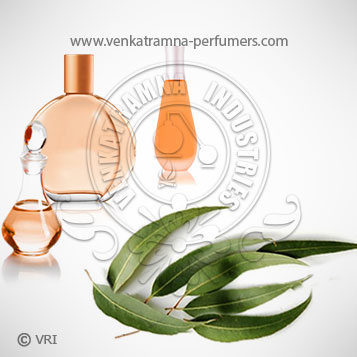
| Botanical Name | Eucalyptus Citriodora Oil |
| Common Name | It has various common names, which are lemon myrtle, lemon scented myrtle, lemon scented ironwood. |
| Country of Origin | India |
| Solubility | 1ml soluble in 2ml of 80% ethanol |
| Specific Gravity | Between 0.864 and 0.8770 at 15 C |
| Optical Rotation | -4°. ~ +5@15.5°.c |
| Refrective Index | 1.4511-1.4681@ 20 c |
| PlantPart | Leaves |
| Bland With | It blends with harsh lemon herb balsamic cool. |
| CAS No | 8000-48-4 |
| Flash Point | 74.4° C. |
| Extraction Method | Steam Distilled |
Eucalyptus, (genus Eucalyptus), large genus of more than 660 species of shrubs and tall trees of the myrtle family (Myrtaceae), native to Australia, Tasmania, and nearby islands. In Australia the eucalypti are commonly known as gum trees or stringybark trees. Many species are cultivated widely throughout the temperate regions of the world as shade trees or in forestry plantations. Economically, eucalyptus trees constitute one of the most valuable groups within the order Myrtales. The eucalypti grow rapidly, and many species attain great height. The giant gum tree, or mountain ash (Eucalyptus regnans), of Victoria and Tasmania, is one of the largest species and attains a height of about 90 metres (300 feet) and a circumference of 7.5 metres (24.5 feet). Many species continually shed the dead outermost layer of bark in flakes or ribbons, whereas certain other species have thick textured bark. The leaves are leathery and often hang obliquely or vertically; most species are evergreen. The flower petals cohere to form a cap when the flower expands. The capsule fruit is surrounded by a woody cup-shaped receptacle and contains numerous minute seeds. Possibly the largest fruits—from 5 to 6 cm (2 to 2.5 inches) in diameter—are borne by mottlecah, or silverleaf eucalyptus.
It is native to Australia but now it also grows in California, Brazil, Spain, Portugal and China. The leaf glands of many species, especially black peppermint tree (E. salicifolia) and Tasmanian bluegum (E. globulus), contain a volatile aromatic oil known as eucalyptus oil. Its chief use is medical, and it constitutes an active ingredient in expectorants and inhalants. Tasmanian bluegum, northern gray ironbark (E. siderophloia), and other species yield what is known as Botany Bay kino, an astringent dark reddish resin, obtained in a semifluid state from incisions made in the tree trunk.
Color : colorless to pale yellow liquid with fresh,strong smell of rose-citronella odor,
Aroma : Lemon-odor
It has major constituents like citronellal (63.6%), a-citronellol (7.3%), isopulegol isomers (6.5%), citronellyl acetate (2.6%), p-cymene (2.5%), citronellal dimmers (2.5%), a-pinene (2.1%) and ß-caryophyllene (1.2%).
Generally applicable in floorwash & perfumes, it is also used on humans and their clothing to repel insects. Citriodora Oil this is also excellent to be used for dandruff, insect repellent, herpes, candida, fever, hair loss. The cooling scent of Eucalyptus Essential Oil is used in aromatherapy to relieve mental exhaustion and rejuvenate the human spirit. It boosts circulation to the brain and reduces harmful surface and airborne pathogens upon contact. Essence of Eucalyptus Oil As A Perfume Ingredient, adding eucalyptus to a fragrance can be a very tricky endeavor because it is so potent that it can easily dominate any scented formulation and deteriorate into ‘an unwanted hint-of-mothball’ aspect. Typically used as a minty, woody, citrusy middle note in fragrances, eucalyptus is known for its fresh clean aroma and is often found in soaps, detergents, mouthwashes and lotions as well as perfume. It adds an airiness to any fragrance with its fresh, green, camphor-like and lemony aspects.